The Dell XPS 13 (9300) Review: Return of the King
by Brett Howse on July 16, 2020 10:00 AM ESTGPU Performance
One area where Intel-based notebooks had previously was in the graphics department, and with Intel’s launch of Ice Lake they directly addressed that. Along the way, Intel has also joined AMD in more aggressively demarcating their integrated GPUs based on the price of the processor. Intel always had a small bit of variation in the included GPU, but for the most part, a Core i3, i5, or i7 U-series would generally offer the same 24 Execution Unit GPU configuration. With Ice Lake, the naming scheme now includes the GPU size in the processor name, with G1, G4, and G7 graphics options, meaning lower-priced Core i3 and i5 models will not necessarily be outfitted with the same iGPU as a Core i7.
| Intel 10nm Ice Lake-U Series CPUs | |||||||||
| AnandTech | Cores Threads |
Base Freq |
1C Turbo |
AC Turbo |
GPU EUs |
GPU Freq |
L3 Cache |
TDP | |
| Core i7-1068G7 | 4 Cores 8 Threads |
2.3 | 4.1 | 3.6 | 64 | 1100 | 8 MB | 28 W | |
| Core i7-1065G7 | 4 Cores 8 Threads |
1.3 | 3.9 | 3.5 | 64 | 1100 | 8 MB | 15 W 25 W |
|
| Core i5-1035G7 | 4 Cores 8 Threads |
1.2 | 3.7 | 3.3 | 64 | 1050 | 6 MB | 15 W 25 W |
|
| Core i5-1035G4 | 4 Cores 8 Threads |
1.1 | 3.7 | 3.3 | 48 | 1050 | 6 MB | 15 W 25 W |
|
| Core i5-1035G1 | 4 Cores 8 Threads |
1.0 | 3.6 | 3.3 | 32 | 1050 | 6 MB | 15 W 25 W |
|
| Core i3-1005G1 | 2 Cores 4 Threads |
1.2 | 3.4 | 3.4 | 32 | 900 | 4 MB | 15 W 25 W |
|
This comes into play since Dell offers three processor options on the XPS 13, with both the Core i3 and Core i5 variants only offering the G1 graphics. To be clear, even the G1 Generation 11 graphics on Ice Lake are a larger GPU than the previous Gen 9.5 offered, with even the lowliest Core i3 featuring 32 Execution Units, but the full GPU in this laptop is only found if you choose the Core i7 model, which offers the 64 Execution Unit G7 graphics. It makes choosing the processor a bit more complex than it used to be, as it would be on an AMD-based laptop which follows the same mantra.
Dell shipped the XPS 13 review unit with the Core i7-1065G7, and as such this device does feature the full-sized GPU, and as we have seen in other Ice Lake based notebooks, the larger GPU is a significant improvement over previous designs.
3DMark
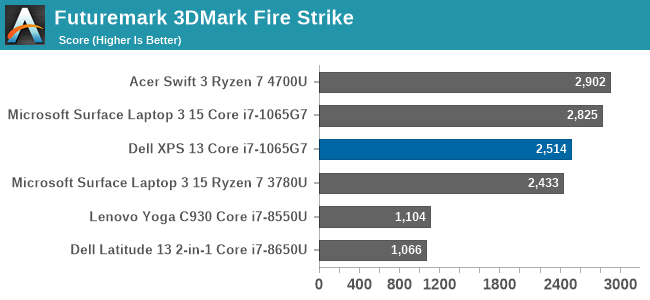
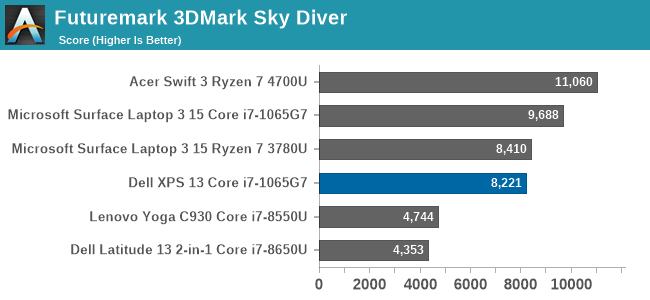

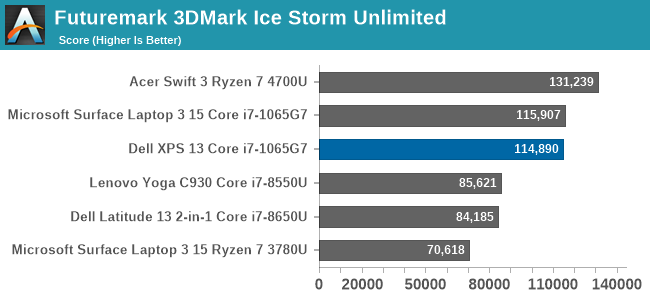
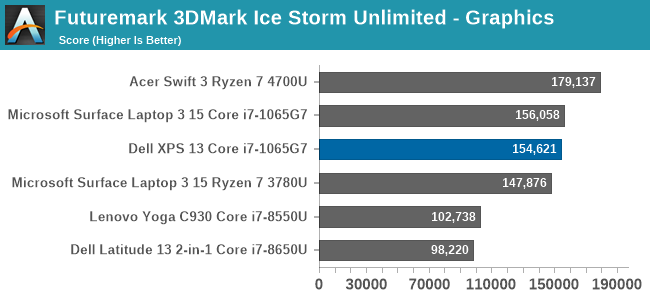
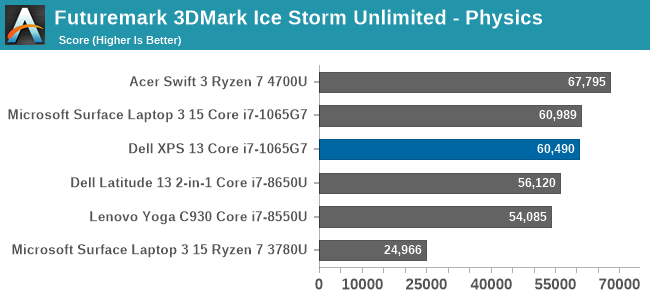
In our first synthetic test, the XPS 13 finishes slightly behind other Ice Lake notebooks, but not by a wide margin.
GFXBench
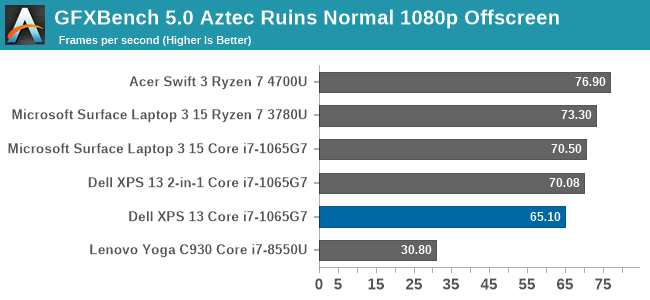

We run the DirectX 12 tests from version 5 of GFXBench, and as expected, the XPS 13 scores right in the same range as expected.
Tomb Raider
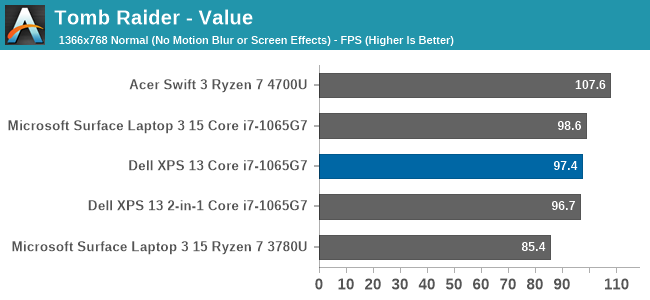
The original Tomb Raider has been a challenge on integrated GPUs, but with AMD’s Ryzen and Intel’s Ice Lake, the game is finally playable although without any extreme graphics settings enabled. Once again, the XPS 13 slots in right where it is expected.
Rise of the Tomb Raider
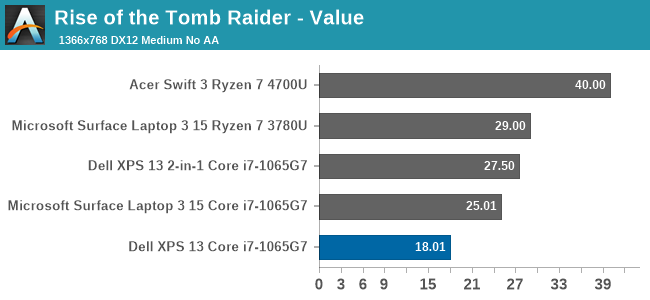
The first sequel to the re-launched Tomb Raider series is much more graphically demanding, and the XPS 13 slides out of the playability window even at the lowest settings we test at.
Strange Brigade
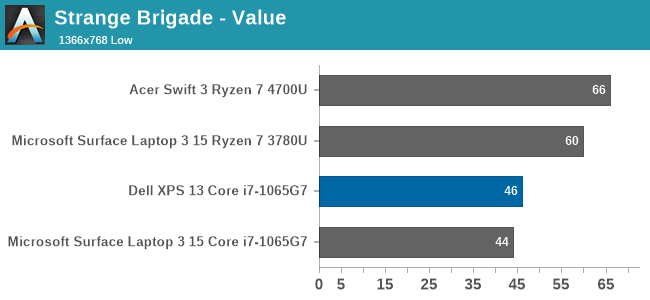
Strange Brigade is a game with a wide-range of settings, and can be very playable even on integrated graphics. As seen with Rise of the Tomb Raider though, the XPS 13 is not quite as performant as some of the other Ice Lake notebooks we have tested.
F1 2019
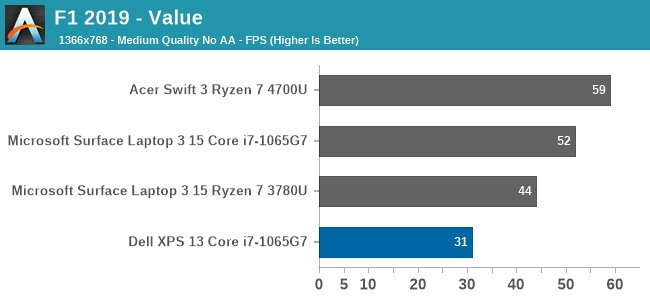
Codemaster’s F1 simulator did not fare very well on the XPS 13, scoring well under expectations. This game can be very CPU limited as well, so TDP can be a major factor.
Far Cry 5

Like most of the other games, we see that Far Cry 5 is once again below other Ice Lake systems, but even on the best integrated system Far Cry is only barely playable regardless.
GPU Conclusion
Although the XPS 13 was outfitted with the top of the range Core i7-1065G7, with its full 64 Execution Unit GPU, the XPS 13 was not quite able to match some of the other Ice Lake systems we have seen. We will get into that a bit more in the thermals section, but this is likely due to Dell more aggressively clamping the processor to its recommended 15-Watt TDP, where other manufacturers may be more aggressive and allow 20+ Watts. Since the GPU is one area where more thermal headroom is always welcomed, this can have a larger impact than a CPU-bound task.
Otherwise, while the Ice Lake G7 GPU configuration is nothing short of a massive step up from Intel's earlier integrated GPUs, they are also competing with AMD in a field that's normally AMD's strength. So for as fast as the G7 configuration is, it and the XPS 13 end up trailing laptops based on the half-a-generation newer AMD Ryzen 4000 APUs.










224 Comments
View All Comments
gescom - Friday, July 17, 2020 - link
You have a kind of sick desperation in your laugh.https://www.notebookcheck.net/Lenovo-ThinkPad-T14s...
Korguz - Friday, July 17, 2020 - link
gescom, more like a sick desperation to keep praising his god intel, and to bash amd any chance he can.ikjadoon - Thursday, July 16, 2020 - link
IIRC, this was not mentioned by Anandtech, but this laptop (and many, many, many, many) others from the premium Ultrabook category are partnered directly with Intel through the Project Athena program, aka the "Engineered for Mobile Performance" badge you sometimes see.It gives a lot of manufacturing / R&D support while also demanding a minimum set of specifications; I think, in the end, it's a win for OEMs as they get a better product (a virtuous cycle) and they get R&D support directly from Intel on the entire notebook (not just the CPU or wireless).
I think 9/10 premium Ultrabooks are Project Athena certified.
I do believe AMD has launched a rival program with Renoir, but it may take time to gain traction. Tiger Lake vs Zen3-based mobile is going to be exciting and AMD absolutely deserves far better than the relatively average performers they keep getting stuck with.
See Anandtech's reporting here: https://www.anandtech.com/show/14444/intels-projec...
TheinsanegamerN - Thursday, July 16, 2020 - link
I've said for years that AMD needs to partner with a smaller brand like MSI or Clevo and show the world what a proper AMD notebook looks like.I was saying this back in the Llano days where nobody wanted to make a ultrabook style laptop with the A8-3500mx.
jeremyshaw - Thursday, July 16, 2020 - link
They did, with HP, a company with historically strong AMD ties in their consumer line. It didn't go well. Whomever thought bulldozer on netbooks was a good idea, is hopefully no longer calling shots at AMD or HP anymore.eastcoast_pete - Thursday, July 16, 2020 - link
I made the mistake of buying one, and it was bad. The sooner that whole period is buried and forgotten, the better for AMD.lmcd - Thursday, July 16, 2020 - link
If you're referring to the entire Bulldozer family history, I gotta say my Toshiba Satellite with an A8-4500M was actually pretty solid for a number of years. Yea the battery life was trash but performance held up for years, especially with dual-channel memory that I upgraded it to.drothgery - Thursday, July 16, 2020 - link
Depends what they think AMD and Intel will be offering next year, I'd imagine.Most vendors wouldn't have even started designing an AMD premium notebook until after they had real performance and power usage data on Ryzen 4xxx, and even then wouldn't bother unless they were fairly confident Intel wouldn't be able to match it fairly soon.
Cinebench multithread (and other embarrassingly parallel benchmarks) notwithstanding, there's really not much value in more than 4 core/8 threads for most consumers (servers and workstations are another matter); Amdhal's law is still real. But the optics of selling 4 cores vs 8 aren't great, and at least initially, Tiger Lake U will still be a quad core.
Spunjji - Friday, July 17, 2020 - link
"Most vendors wouldn't have even started designing an AMD premium notebook until after they had real performance and power usage data on Ryzen 4xxx"They would have had that data a long time before the platform shipped - Asus couldn't have designed the class-redefining Zephyrus 14 without it. They managed to create a whole new category of gaming sub-notebook, yet most of the larger OEMs couldn't manage to get one into an existing Ultrabook chassis. 🤔
Deicidium369 - Friday, July 17, 2020 - link
Yeah agree there - the OEMs have had access to the specifics of Renoir - but likely will repurpose previous designs, since Renoir is largely like the previous (3xxx APUs, don't know the names) - from an electrical and packaging point of view.I can't imagine having a laptop as a gaming platform - Opus Magnum maybe - but not BF5. But every use case is different - there used to be a DTR slot in my lineup - but not any more.